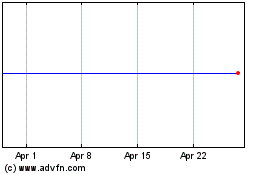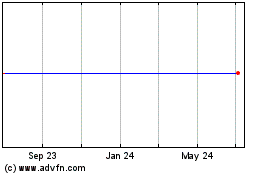FARXIGA Phase III DAPA-CKD Trial Will Be Stopped Early After Overwhelming Efficacy in Patients With Chronic Kidney Disease
March 30 2020 - 7:05AM
Business Wire
FARXIGA is the first SGLT2 inhibitor to show
meaningful benefit in patients with chronic kidney disease in a
trial including both type-2 diabetics and non-diabetics
The Dapagliflozin And Prevention of
Adverse outcomes in Chronic Kidney
Disease (DAPA-CKD) Phase III trial for
FARXIGA (dapagliflozin) in patients with chronic kidney disease
(CKD) will be stopped early following a recommendation from an
independent Data Monitoring Committee (DMC) based on its
determination of overwhelming efficacy.
The decision to stop the trial early was made following a
routine assessment of efficacy and safety which showed FARXIGA’s
benefits earlier than originally anticipated and AstraZeneca will
now initiate closure of the trial.
Mene Pangalos, Executive Vice President, BioPharmaceuticals
R&D, said: “Chronic kidney disease patients have limited
treatment options, particularly those without type-2 diabetes. We
are very pleased the Data Monitoring Committee concluded that
patients experienced overwhelming benefit. FARXIGA has the
potential to change the management of chronic kidney disease for
patients around the world.”
The co-chairs of the trial and its Executive Committee Prof.
David Wheeler, University College London, and Prof. Hiddo L.
Heerspink, University Medical Center Groningen, said: “It has been
a privilege to be involved in this trial. We are delighted with the
Data Monitoring Committee recommendation and look forward to
sharing the results with the medical community and patients with
chronic kidney disease.”
The primary endpoint of DAPA-CKD is a composite of worsening of
renal function or death (defined as a composite endpoint of ≥50%
sustained decline in estimated glomerular filtration rate (eGFR),
onset of end stage renal disease (ESRD) or cardiovascular (CV) or
renal death) in patients with CKD irrespective of the presence of
type-2 diabetes (T2D).
The full results will be submitted for presentation at a
forthcoming medical meeting and AstraZeneca will now initiate
discussions with global health authorities regarding early
regulatory submissions.
In August 2019, the US Food and Drug Administration (FDA)
granted Fast Track designation for the development of FARXIGA to
delay the progression of renal failure and prevent CV and renal
death in patients with CKD. In January 2020, following positive
data for the landmark Phase III DAPA-HF Trial, the US Food and Drug
Administration (FDA) accepted a supplemental New Drug Application
(sNDA) and granted Priority Review for FARXIGA to reduce the risk
of CV death or the worsening of Heart failure (HF) in adults with
heart failure with reduced ejection fraction (HFrEF) with and
without Type-2 diabetes. The Prescription Drug User Fee Act date,
the FDA action date for this supplemental application, is scheduled
for the second quarter of 2020.
FARXIGA is indicated as an adjunct to diet and exercise to
improve glycemic control in adults with T2D. In the US it is also
approved to reduce the risk of hospitalization for HF in patients
with T2D and established CV disease or multiple CV risk
factors.
Indication and Limitations of Use for FARXIGA®
(dapagliflozin) tablets
FARXIGA is indicated:
- as an adjunct to diet and exercise to improve glycemic control
in adults with type 2 diabetes mellitus
- to reduce the risk of hospitalization for heart failure in
adults with type 2 diabetes mellitus and established cardiovascular
disease or multiple cardiovascular risk factors
FARXIGA is not recommended for patients with type 1 diabetes
mellitus or for the treatment of diabetic ketoacidosis.
Important Safety Information for FARXIGA® (dapagliflozin)
tablets
Contraindications
- Prior serious hypersensitivity reaction to FARXIGA
- Severe renal impairment (eGFR <30 mL/min/1.73 m2), end-stage
renal disease, or patients on dialysis
Warnings and Precautions
- Hypotension: FARXIGA causes intravascular volume
contraction, and symptomatic hypotension can occur. Assess and
correct volume status before initiating FARXIGA in patients with
impaired renal function, elderly patients, or patients on loop
diuretics. Monitor for hypotension
- Ketoacidosis has been reported in patients with type 1
and type 2 diabetes receiving FARXIGA. Some cases were fatal.
Assess patients who present with signs and symptoms of metabolic
acidosis for ketoacidosis, regardless of blood glucose level. If
suspected, discontinue FARXIGA, evaluate and treat promptly. Before
initiating FARXIGA, consider risk factors for ketoacidosis.
Patients on FARXIGA may require monitoring and temporary
discontinuation in situations known to predispose to
ketoacidosis
- Acute Kidney Injury: FARXIGA causes intravascular volume
contraction and can cause acute kidney injury. Reports of acute
kidney injury requiring hospitalization and dialysis have occurred
with FARXIGA. If acute kidney injury occurs, discontinue and
promptly treat Increases in serum creatinine and decreases in eGFR
may be observed with initiation of FARXIGA. Elderly patients and
patients with impaired renal function may be more susceptible to
these changes. Consider temporarily discontinuing in settings of
reduced oral intake or fluid losses Before initiating FARXIGA,
evaluate renal function and monitor periodically FARXIGA is not
recommended when the eGFR is <45 mL/min/1.73 m 2
- Urosepsis and Pyelonephritis: SGLT2 inhibitors increase
the risk for urinary tract infections [UTIs] and serious UTIs have
been reported with FARXIGA. Evaluate for signs and symptoms of UTIs
and treat promptly
- Hypoglycemia: FARXIGA can increase the risk of
hypoglycemia when coadministered with insulin and insulin
secretagogues. Consider lowering the dose of these agents when
coadministered with FARXIGA
- Necrotizing Fasciitis of the Perineum (Fournier’s
Gangrene): Rare but serious, life-threatening cases have been
reported in patients receiving SGLT2 inhibitors including FARXIGA.
Cases have been reported in females and males. Serious outcomes
have included hospitalization, surgeries, and death. Assess
patients presenting with pain or tenderness, erythema, swelling in
the genital or perineal area, along with fever or malaise. If
suspected, institute prompt treatment and discontinue FARXIGA
- Genital Mycotic Infections: FARXIGA increases the risk
of genital mycotic infections, particularly in patients with prior
genital mycotic infections. Monitor and treat appropriately
Adverse Reactions
In a pool of 12 placebo-controlled studies, the most common
adverse reactions (≥5%) associated with FARXIGA 5 mg, 10 mg, and
placebo respectively were female genital mycotic infections (8.4%
vs 6.9% vs 1.5%), nasopharyngitis (6.6% vs 6.3% vs 6.2%), and
urinary tract infections (5.7% vs 4.3% vs 3.7%).
Use in Specific Populations
- Pregnancy: Advise females of potential risk to a fetus
especially during the second and third trimesters.
- Lactation: FARXIGA is not recommended when
breastfeeding.
Dosing
- To improve glycemic control in patients with T2D, the
recommended starting dose of FARXIGA is 5 mg once daily, taken in
the morning. In patients tolerating FARXIGA 5 mg once daily who
require additional glycemic control, the dose can be increased to
10 mg once daily.
- To reduce the risk of hospitalization for heart failure in
patients with T2D, the recommended dose of FARXIGA is 10 mg once
daily.
Please see accompanying US Full Prescribing Information and
Medication Guide for FARXIGA.
Notes
Chronic kidney disease
CKD can be a serious, progressive condition defined by decreased
kidney function (shown by reduced eGFR or markers of kidney damage,
or both, for at least three months.) The most common causes of CKD
are diabetes and hypertension and glomerulonephritis. CKD is
associated with significant patient morbidity and an increased risk
of CV events, such as HF and premature death. In its most severe
form, known as ESRD, kidney damage and deterioration of kidney
function have progressed to the stage where dialysis or kidney
transplantation are required. The majority of patients with CKD
will die from CV causes before reaching ESRD.
DAPA-CKD
DAPA-CKD is an international, multi-centre, randomised,
double-blinded trial in 4,245 patients designed to evaluate the
efficacy of FARXIGA 10mg, compared with placebo, in patients with
CKD stages 2–4 and elevated urinary albumin excretion, with and
without T2D. FARXIGA is given once daily in addition to standard of
care. The primary composite endpoint is worsening of renal function
(defined as a composite of an eGFR decline ≥50%, onset of ESKD and
death from CV or renal cause). The trial is being conducted in 21
countries. The efficacy-stopping guideline in the trial protocol
and DMC Charter state that after evaluating the totality of the
available efficacy and safety data, the DMC may consider
recommending that the study be stopped for overwhelming
efficacy.
AstraZeneca in CV, Renal & Metabolism (CVRM)
CV, renal and metabolism together form one of AstraZeneca’s main
therapy areas and a key growth driver for the Company. By following
the science to understand more clearly the underlying links between
the heart, kidneys and pancreas, AstraZeneca is investing in a
portfolio of medicines to protect organs and improve outcomes by
slowing disease progression, reducing risks and tackling
co-morbidities. Our ambition is to modify or halt the natural
course of CVMD diseases and potentially regenerate organs and
restore function, by continuing to deliver transformative science
that improves treatment practices and CV health for millions of
patients worldwide.
AstraZeneca
AstraZeneca is a global, science-led biopharmaceutical company
that focuses on the discovery, development and commercialization of
prescription medicines, primarily for the treatment of diseases in
three therapy areas - Oncology, Cardiovascular, Renal &
Metabolism and Respiratory. AstraZeneca operates in over 100
countries and its innovative medicines are used by millions of
patients worldwide. For more information, please visit
www.astrazeneca-us.com and follow us on Twitter @AstraZenecaUS.
View source
version on businesswire.com: https://www.businesswire.com/news/home/20200330005322/en/
Media Inquiries Michele Meixell +1 302 885 2677
Chelsea Ford +1 302 885 2677
AstraZeneca (NYSE:AZN)
Historical Stock Chart
From Mar 2024 to Apr 2024

AstraZeneca (NYSE:AZN)
Historical Stock Chart
From Apr 2023 to Apr 2024
